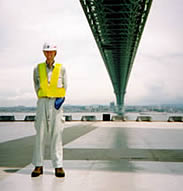Fourth Year Engineering
Designing long span bridges and tall buildings
(Structural Engineering Project, Simon de Neumann)
 Anyone who has crossed a long-span suspension bridge, or stood at the top of a tall building, on a windy day will have experienced the effect of that wind in causing movement of the structure. The possibility of the catastrophic failure of a structure caused by wind effects has been known to design engineers since 1940, when the Tacoma Narrows bridge in the USA collapsed due to a phenomenon called flutter: the bridge was filmed undulating wildly before final collapse. Simon de Neumann decided to investigate this phenomenon for his fourth year project, based on structural engineering.
Anyone who has crossed a long-span suspension bridge, or stood at the top of a tall building, on a windy day will have experienced the effect of that wind in causing movement of the structure. The possibility of the catastrophic failure of a structure caused by wind effects has been known to design engineers since 1940, when the Tacoma Narrows bridge in the USA collapsed due to a phenomenon called flutter: the bridge was filmed undulating wildly before final collapse. Simon de Neumann decided to investigate this phenomenon for his fourth year project, based on structural engineering.
"Flutter is a phenomenon caused by the interaction of wind on a structure. Flutter is destructive. If you look out of an aircraft window and see the wings bouncing up and down: this is an aero-elastic interaction, as is flutter. Fortunately aircraft wings are designed to avoid flutter and to cope with this flapping effect without failing. It is important that structures are designed against aero-elastic effects too. Hopefully you will never see flutter develop in a building or a bridge - if you do, it might be the last thing you will see!
 At the moment, long span bridges and tall buildings are designed in a very conservative way, to allow for wind effects. A greater understanding of what is going on will allow more adventurous, yet safe, designs.
At the moment, long span bridges and tall buildings are designed in a very conservative way, to allow for wind effects. A greater understanding of what is going on will allow more adventurous, yet safe, designs.
I chose this project because it combined practical experimentation with theory and allows me to build up my knowledge in the subject of aero-elasticity, which is the field in which I want to work. For my project, I have built two models: one of a radically designed tall building, the new 'Glasgow Wing Tower' which is 100m high and the other of a long span bridge which has been designed to span 3.3 km to cross the Messina Straits in Italy.
 I had to get the design details of these structures from the engineering companies involved and having built the models, I have looked at how they react to different wind conditions using a wind tunnel. Smoke patterns, such as the one shown, allow me to visualise the effects, with the aid of which I can then thoroughly compare the practical results with the theory. Some of my results have been quite surprising, and I have been able to discuss them with the designers involved in the projects in industry.
I had to get the design details of these structures from the engineering companies involved and having built the models, I have looked at how they react to different wind conditions using a wind tunnel. Smoke patterns, such as the one shown, allow me to visualise the effects, with the aid of which I can then thoroughly compare the practical results with the theory. Some of my results have been quite surprising, and I have been able to discuss them with the designers involved in the projects in industry.
I would like, one day, to be involved in the design of a longer span bridge than any that have been built before. To do this I will need a good understanding of the principles of aero-elasticity."
When Simon graduates he will be working for a small engineering company, specialising in aero-elastic design.

